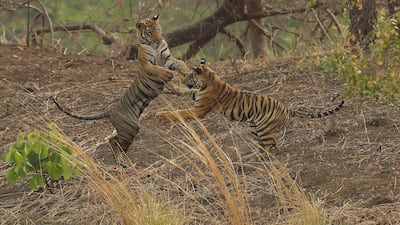Wildlife photographer and filmmaker Aishwarya Sridhar was 14 when she first met Maya at the Tadoba Andhari National Park, a wildlife sanctuary in her home state of Maharashtra in India.
The tiger was only a cub then, frolicking in the patchy dirt by her parents, nibbling her mother’s paw and tugging at her father’s tail.
It would take another two years for Sridhar to decide to feature Maya as the star of her National Geographic documentary Tiger Queen of Taru, which premiered regionally on OSN on Monday, January 25. But even then, she knew the cub was special.
“Maya stood out from the rest of her siblings,” says Sridhar, 24. “She was everywhere. Whoever came to see her at the park knew she would grow up to be queen.”
But what no one could have anticipated was that Maya’s mother, Leela, would die so soon, having reportedly been killed by a snake bite, leaving the cubs without their mother.
“Maya’s childhood years were tough on her, but she eventually chose to take up her mother’s throne and expanded it to cover the largest territory in the national park.”
But the worst was still ahead of Maya. One day, after returning from a hunt, the tiger discovered her own three cubs had gone missing and that her territory had been raided by a young male tiger. Devastated but undeterred, she left her area and went out to the farthest reaches of the sanctuary, bringing back with her a former mate to help drive out the intruder.
"I realised then that Maya was special as she reclaimed her territory," says Sridhar, who was watching all this transpire from her vantage point. "We thought the cubs had died, though. But three months down the line, she managed to reunite with them."
That was when Sridhar knew she had to capture this remarkable tiger on film. It's a story of perseverance, love, blood and broken allegiances. Sridhar compares the events in the tiger's life to that of a Bollywood film. It is for good reason, she says, that Maya is probably the most popular big cat in India. A quick Google search shows this to be true.
Between disparate blog posts, photographs and videos showing Maya hunting deer, fighting rivals or prowling between safari jeeps in the reserve, it is evident that she may be one of the world's most documented tigers. However, none of these entries give us the sweeping and surprisingly inspiring insight into Maya's adventures and trials as Tiger Queen of Taru does.

Sridhar began working on the project in 2014. Carrying her camera as well as schoolbooks with her, she would go to the reserve to film the tiger. She says it was tough, balancing between her school life and the shoot, but her friends were there to help.
“I couldn’t go and continuously be on the field, especially when I had my board exams, so a lot of my friends pitched in,” she says.
When Sridhar had finished putting the film together, its footage caught the attention of South African production company Earth-Touch, and after developing the project, she managed to house the documentary in National Geographic.
As much as the film is dedicated to Maya, Sridhar says she hopes it will help forge a new-found appreciation for big cats.
"Most people think tigers are just carnivores incapable of having a thought process," she says. "They think that they are raw, carnal and aggressive in nature, but that's not what I experienced with the tigers I have interacted with in central India. Most of them, especially Maya, have the capability to strategise and are able to think in a human-like way."
Sridhar is thrilled that Maya’s story is going worldwide and hopes that viewers learn as much from the tiger queen as she has.
"I learnt that no matter how many failures you have in life, you should be persistent," Sridhar says. She has learned this from the tiger. "There are several competing tigers who are vying for her home. It's not easy to govern such a large area."
Sridhar's documentary was years in the making, but that's not to say she hasn't been working on other projects. In 2018, the young documentarian and photographer released Panje: The Last Wetland, which was broadcast on India's state-owned DD National television station.
“At that point, I was seeing a lot of wetlands around my home getting destroyed and I wanted to do something about that,” she says. “That was my first project and I learnt editing, as well as the process of sound-mixing and presenting, with that documentary.”
Panje: The Last Wetland eventually managed to convince the Bombay High Court to issue an order to stop the reclamation of the wetland.
Sridhar says she was always drawn to wildlife, thanks to her father, who is a member of the Bombay Natural History Society.
“On my 11th birthday, my father gave me a point-and-shoot camera,” she recalls. “Since then, I’ve wanted to document wildlife more and more with every camera leading to a bigger camera. At some point my friends started teasing me and saying my camera was getting as tall as I was.”
Sridhar says she has a number of projects lined up for the year, including a documentary series that puts the spotlight on the primates of India.
“I want to document their survival stories while going out in search of these primates, some of which are critically endangered. There are very few of them left in the wild today and I want to show that it’s important to preserve them.”


